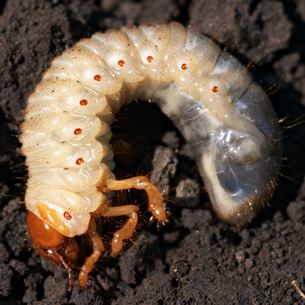How to Control Lawn Grubs

Adult Lawn Grubs (Japanese Beetles)
Have you ever raised concerns about lawn grubs and ways to eradicate them? The most probable time for lawn grubs to start appearing in most of the country is later summer and into the autumn. Even though a relatively small degree of lawns will in fact experience lawn grub damage, these worms can rapidly cause grave damage to your lawn and will cause to to try almost anything to rid you turf of these terrible insects.
How Do You Know If You Have Lawn Grubs?
These grubs, additionally known as white grubs, feed on the turf root structure, causing wilting and browning in big, irregular-shaped areas. However, in late summer, there can be countless other reasons why your lawn will turn brown. Always examine the root zone of affected areas for the white, grubs. It is most beneficial to check the marginal areas of turf, where the brown and healthy areas meet. Pull back the turf in a couple of these areas. A lawn grub count of more than 10 to 12 grubs per square foot will lead to the wilting and browning of your turf.
Other circumstances can be mistaken for a lawn grub infestation that similarly cause turf browning - for example:
- lawns in shaded areas often have weak roots and are pulled-up quite easily.
- Grubs do not commonly appear in shade lawns.
- Also, in early spring, the turf can easily be lifted and can be mistaken for a lawn grub problem.
- Be aware that if for any reason the grass dies, the roots rot and the turf can be easily ripped out.
- Do not try to diagnose grub damage in the spring from the previous season's damage as this is very complicated to do, even if you have dead turf and minimal root structure.
An alternative sign of grubs is damage from skunks and raccoons digging up lawns at night, in search of grubs to eat. Although a mole problem can indicate that you have a lawn grub infestation, it is not an absolute conclusion.
Why does my lawn have grubs but not my neighbor?
The adult stage of the white grub's life cycle is the Japanese Beetle and they can fly. So if they fly to your lawn and not your neighbor's, it is by random chance. Also keep in mind that these beetles prefer to lay their eggs in full-sun turf areas that are well watered. Most frequently the Japanese beetle lays their eggs in July. So if it has been dry, and you have watered your turf you are surrounded by dry turf, the beetle will likely select your lawn.
Lawn Grubs - Can You Predict If You Will Have Them?

Lawn Grub
There are several definite indicators that will influence whether you have lawn grubs appearing in your turf.
One very clear indication is if you discover a ton of beetle on your turf during the month of July.
Also if around sundown or shortly after sundown, you see active tan beetles, these are adult white grubs called Masked Chafers.
Japanese beetles are typically active during the day and feed heavily on many ornamentals.
Keep a watchful eye on your lawn starting in the middle of August and into September.
Look for wilting and browning areas, and be sure the check the root zone for grubs.
How Can You Prevent Lawn Grub Damage?
There are various options that you can examine. One of the more extreme options is to stop irrigating your lawn during the month of July and let the turf go dormant. This will deter beetles from laying their eggs in your lawn. The downside of this option is the lawn will be brown and dormant.
A better option is investigate the use of a lawn grub control substance. If there has been known problems in your lawn or your neighbors turf, you ought to apply a natural grub control substance.
How Can I Get Rid Of Lawn Grubs?
Probably the best preemptive measure is the application of an organic bacterial powder on your turf. Although the poisons available will certainly do the job and kill your grubs, you risk pollution of the water table and killing song birds. Also you risk the introduction of unhealthy circumstances to your pets and family. One of the best treatments is Milky Spore and can control lawn grubs for up to 10 years if applied correctly.
Is There Anything You Need To Do To Repair Your Lawn?
If there has been significant damage to your lawn, you should apply various lawn restoration strategies. To begin the restoration process, rake away all of the dead debris. Next, be sure to water the damaged areas very thoroughly as some of the damaged roots may recover and this is especially effective in cooler weather. Finally re-seeding will be required in areas that don't recover, or are entirely bare or severely thin. About the most beneficial time of the year to begin your lawn restoration efforts tends to be right around Labor Day for many parts of the country.
comments powered by Disqus


































































